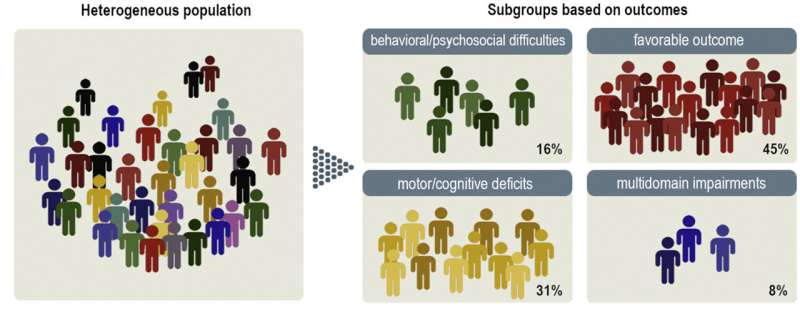How do children develop after being born very preterm? Four likely outcomes

A study in the Journal of the American Academy of Child and Adolescent Psychiatry (JAACAP) reports that, among very preterm born children, subgroups can be distinguished with distinct outcome profiles that vary in severity, type, and combinations of deficits.
Children born very preterm, that is, after a pregnancy duration of less than 32 weeks, have a higher risk for difficulties during development than peers who are born after a normal pregnancy duration. What kind of difficulties and to what degree, however, varies strongly from child to child. Nevertheless, very preterm born children are usually considered as one group. According to new research, this assumption is unjustified.
Researchers from the Obstetrical, Perinatal and Pediatric Epidemiology Research Team at Inserm and the French National Institute for Health and Medical Research followed the development of 2,000 very preterm born children from all over France from birth until the age of 5.5 years. Their findings suggested that the population of very preterm born children could be divided into four subgroups, each with a different profile of developmental outcomes.
Almost half of the children (45%) belonged to a subgroup of children who had no difficulties and functioned at similar levels as their full-term born peers. However, 55% of the children belonged to one of three subgroups with suboptimal developmental outcomes. The first subgroup consisted of children who primarily had difficulties in motor and cognitive functioning, whereas a second group of children primarily had difficulties in behavior, emotions, and social relationships. A small subgroup of children had more severe impairments in all domains of development.
"Very little is known about the specific needs of subgroups of very preterm born children," said lead author Sabrina Twilhaar, Ph.D. "Our study is the first large-scale study to distinguish very preterm born children based on their profile of outcomes across multiple important developmental domains. After all, how children function in everyday life is not determined only by their IQ or behavior. We now have a better understanding of which difficulties are prominent in different subgroups and which difficulties often occur together. This is important information for the development of targeted interventions."
The researchers were also interested to know the predictors of these developmental outcomes. They found that children in the three subgroups with suboptimal outcome profiles were more often boys or had parents with a lower level of education or with a non-European migration background. Children who were diagnosed with prematurity-related lung disease (i.e. bronchopulmonary dysplasia) also had a higher risk for suboptimal developmental outcomes.
New insights are highly needed for very preterm born children. Preterm birth rates are increasing as are survival rates, especially among the most immature infants who have the highest risk for impairments. Thus, the number of very preterm born children with impairments growing up in our societies is rising. These impairments generally persist when children get older and there is currently little evidence in support of interventions that meaningfully improve long-term outcomes. These insights may be used to tailor support programs to the specific needs of subgroups of children to improve their effectiveness.
Dr. Twilhaar said, "Instead of taking a one-size-fits-all approach, the findings emphasize the importance of taking individual differences much more into account. The average of the population is not representative of the individual children that it consists of. Moving forward, we should thus aim to understand how certain combinations of difficulties arise in specific groups of children, whereas others encounter no difficulties at all. This will aid the development of interventions that are tailored to the actual needs of individual children and target co-occurring problems, but also programs and policy to promote positive development in all children."
More information: E. Sabrina Twilhaar et al, Profiles of Functioning in 5.5-Year-Old Very Preterm Born Children in France: The EPIPAGE-2 Study, Journal of the American Academy of Child & Adolescent Psychiatry (2021). DOI: 10.1016/j.jaac.2021.09.001


















